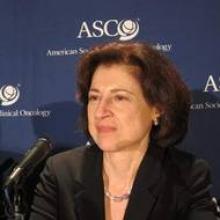Results from KEYNOTE-001 show that not only is the anti-PD-L1 antibody pembrolizumab clinically active in advanced non–small cell lung cancer, but that PD-L1 expression is a marker of response, as well.
The objective response rate was 45.2% for patients with programmed cell death ligand 1 (PD-L1) expression in at least half of their tumor cells, including 44% in previously treated patients and 50% in treatment-naive patients.
For patients with 1% to 49% and < 1% tumor PD-L1 expression, objective response rates were 16.5% and 10.7%, respectively, Dr. Edward Garon of the University of California, Los Angeles, reported at the annual meeting of the American Association for Cancer Research.
About a quarter of those screened had PD-L1 expression in at least half of their tumor cells.
Median progression-free survival (PFS) in this subgroup was 6.3 months vs. 3.3 months in patients with 1%-49% tumor PD-L1 and 2.3 months in those with < 1% PD-L1.
After a median follow-up of 10.9 months, median overall survival was not reached in patients with at least 50% tumor PD-L1 expression and was 8.8 months in both groups with lesser degrees of tumor PD-L1 expression, according to results simultaneously reported in the New England Journal of Medicine (2015 April 19 [doi:10.1056/NEJMoa1501824]).
“I think that with [these] data, we can now confidently say that in previously treated patients who have PD-L1 expression in at least half of their cells, pembrolizumab is associated with superior clinical outcomes, clearly, than what would be anticipated with cytotoxic chemotherapy,” Dr. Garon said during a press briefing.
Outcomes in patients with lesser tumor PD-L1 expression may also be better than what is seen with comparators, but complete data on that will require data from randomized studies, he added.
Press briefing moderator Dr. Suzanne Topalian, with the Johns Hopkins Sidney Kimmel Comprehensive Cancer Center in Baltimore, pointed out that more than three-fourths of patients in the study had progressed on prior systemic therapies.
“This is a very difficult-to-treat patient population where the impact of second- and third-line agents is generally not expected to prolong survival,” she said. “These results are especially impressive I think in this particular treatment setting.”
Results from KEYNOTE-001 were drawn from 495 patients with advanced or metastatic non–small cell lung cancer, including 182 patients assigned to a training group in which the PD-L1 cutoff value was selected and 313 patients with measurable disease assigned to an independent biomarker validation group. PD-L1 status was assessed in tumor samples by a prototype immunohistochemistry assay using the 22C3 antibody clone (Merck). Patients were randomized to intravenous pembrolizumab 2 mg/kg or 10 mg/kg every 3 weeks or 10 mg/kg every 2 weeks.
In the training group, 171 patients were previously treated and 11 were treatment naive, with 129 remaining after exclusions for cutoff selection. In the validation group, 223 patients were previously treated and 90 were treatment naive, with 204 biomarker evaluable patients remaining after exclusions.
The objective response rate among the entire 495 patients was 19.4%, including 18% in previously treated patients and 24.8% in treatment-naive patients, Dr. Garon said.
Median PFS was 3.7 months, 3.0 months, and 6.0 months and median overall survival 12 months, 9.3 months, and 16.2 months, respectively.
There were no clear differences in efficacy and safety between dosing regimens, he said.
Treatment-related adverse events occurred in 351 patients (71%), the most common being fatigue, pruritus, and decreased appetite. Grade 3 or higher events were reported in 47 patients (9.5%), the most common being dyspnea in 19, pneumonitis in 9 and decreased appetite in 5.
Based on the current data, Dr. Topalian asked how the proposed PD-L1 biomarker would be used in clinical practice. She noted that the situation is more clearcut with the kinase inhibitor class of drugs in which the biology tells us whether the drug is unlikely to work based on whether the patient has a particular mutation, like the BRAFV600E mutation in melanoma.
“This kind of biomarker is a lot more blurry and you saw that even patients with lower levels of expression of this marker still have notable response rates,” Dr. Topalian said.
Dr. Garon responded that there are two important aspects to a biomarker.
“One is that when you select patients who are positive, you do a very good job of enriching for patients with good clinical outcome, and this data set I believe very well addresses that piece,” he said. “The other piece, which is a shortfall and in some respects a fortunate shortfall for someone who treats patients with lung cancer, is that we haven’t done as good a job as we would like with this biomarker of demonstrating the group of people who is not likely to benefit.”



